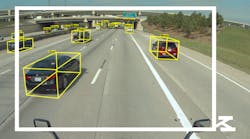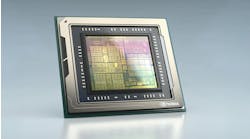Kodiak targets 2023 for driverless trucks in U.S. as it sets up a future in Asia
Kodiak Robotics’ burgeoning self-driving truck technology is targeting human-less freight transport in the Southern U.S. by 2023. And as the global competition heats up for autonomous trucking, the California-based artificial intelligence company is partnering with one of South Korea’s largest conglomerates to sell and distribute Kodiak’s self-driving technology and fleet management services in Asia.
While Kodiak’s main focus continues to be on the North American market, CEO and co-founder Don Burnette told FleetOwner this new partnership with Seoul-based SK Group gets his company’s “foot in the door” of Asia’s $1.5 trillion freight market.
“Our primary focus right now as a company is on the Southern U.S., and we’re going to be gradually expanding over the next several years as we march toward autonomy,” Burnette said during a Zoom interview in advance of the news. “We think that we will be able to take the safety driver out of the cab and really deploy a true driverless solution in the market by 2023.”
Expansion here and abroad
SK Group, a Korea-based conglomerate of more than 120 companies across the globe, is looking to leverage its corporate power to commercialize Kodiak products in Korea, China, and beyond, according to a joint announcement from Kodiak and SK on May 26. Kodiak plans to leverage SK’s products, components, and technology for its autonomous trucking systems, including artificial intelligence (AI) microprocessors and advanced emergency braking systems.
“Kodiak, as an American firm, is not going to just march into Asia and say, ‘We’re here! Here’s our tech, go forth and prosper.’ It’s a process,” Burnette explained. “You need to have the right contacts, the right partnerships, the right network. The trucking industry and logistics is a very complex supply chain. So knowing the right partners, having the right relationships is always step one.”
SK’s network of companies has deep roots in numerous industries critical to the future of logistics, from trucking telematics to shipping to semiconductors. Burnette said the collaboration is “more of a commercial partnership.” He said the two companies aren’t disclosing any financial relationship.
Jungho Shin, executive vice president of SK Inc., said the partnership “will help accelerate the commercialization of self-driving trucks in Asia. Kodiak’s industry-leading technology and SK’s unrivaled reach in Korea and across Asia make this a natural partnership. We look forward to working with Kodiak to make autonomous trucking a reality around the globe.”
Kodiak Driver, the company’s name for its self-driving technology, is currently controlling freight runs between Dallas and Houston along 240 miles of Interstate 45. While expanding its AI-driven truck technology beyond Texas is the priority, Burnette said he wants his company to be ready to expand globally when the time is right.
It’s essential for autonomous technology to get third-party validation, Burnette said. “SK has done a lot of diligence into the autonomous space—they really see it as a core technology of the future and they’re interested in working with Kodiak to make that a reality.”
The U.S and China—with expansive rural areas connected by divided highways—have long been eyed as prime proving grounds for self-driving long-haul trucking. Several U.S.-based tech companies, such as TuSimple, Aurora, and Waymo, are running freight on AI-powered trucks across Texas and other parts of the Southwest. Just like Kodiak, they all have plans and hopes to expand from coast to coast along the U.S. Sunbelt. For now, those Level 4 autonomous trucks have safety drivers in the cabs.
“The benefits of this technology in the U.S. are improved safety,” Burnette said. “Our trucks are never drowsy; they don’t drive drunk; they’re always paying attention, looking 360 degrees around the vehicle at all times. That’s obviously a huge benefit.”
Commercial drivers’ hours-of-service regulations limit how much time a truck driver can spend on the road before taking required rests. “Our trucks can drive, more or less, 24/7 at least to the extent that their gas tank will allow,” Burnette added.
And the gas tanks on autonomous trunks, he noted, need less fueling because computers can get better mpg—about 10% better—than human drivers. This, he said, also helps reduce emissions. “This is a need that exists here in the U.S. It’s a need that exists in China. And it’s a need that exists all over the market,” Burnette said before adding that Australia is another large country ripe for the benefits of Level 4 autonomous trucking.
Burnette said his firm is also working “hand-in-hand with various tier one suppliers in the space” that build technologies such as controllable steering columns and electronically controlled braking systems. “We’re working with all of those different suppliers and vendors to ensure that we have the reliability and redundancy built into the systems because redundancy is ultimately what I believe is the most important and critical aspect of ensuring the safety of these systems.”
Mapping the future
Creating those redundancies is what will make it safe for freight to run along highways without a driver on board. “There’s still more work to do, but we think that the technology roadmap is there to support the technology being feasible in 2023,” he said. “Our target is to bring it to the market in 2023. You’re not going to see it really scale until ’24 and ’25.”
TuSimple, in collaboration with Navistar, already has fleet partnerships planned for human-less trucking by 2024 that will be built into the trucks as they are assembled. Kodiak has a partnership with Paccar that dates back to 2018—its Texas autonomous runs are done with Kenworth T680 tractors. But Kodiak is focused on “retrofitting existing trucks as opposed to having our technology roll off the assembly line,” Burnette said.
Another way that Kodiak is taking a different approach to self-driving development is by not relying on high-definition mapping, which has been “the backbone of the AV industry for over a decade now,” Burnette said.
Along with being expensive to create, HD maps are costly to maintain as they require updates during and after road construction and traffic flow changes. “It can also be more complicated for trucks to be able to drive through those environments when those changes have occurred,” explained Burnette. He said he learned this as he worked on other self-driving projects with Google before co-founding Otto, which was later acquired by Uber. After Uber decided to phase out its autonomous trucking development, Burnette set out on his own and co-founded Kodiak.
“We made the decision on day one at Kodiak that we were going to drive mapless first,” he said. “We were going to ensure that every module within our system is capable of driving without a map.”
Kodiak Driver-controlled trucks use a “lightweight map,” Burnette explained. “It contains lane-level connectivity information that's helpful for routing our trucks to their destinations—much the same way you or I might use Google Maps or Apple Maps.”
The Kodiak AI, he said, can detect road changes in real-time. As the vehicles see those changes, they are uploaded to Kodiak’s cloud infrastructure that then updates its maps for other Kodiak vehicles “so every truck in the system has those updates and are prepared the next time. I think that’s a unique capability of our architecture that other folks in the space have not really been able to match.”




